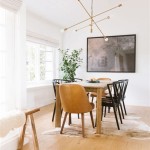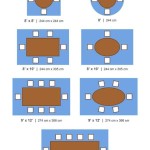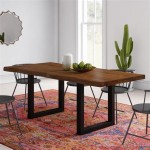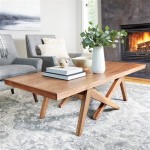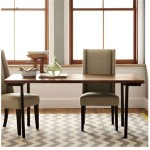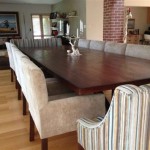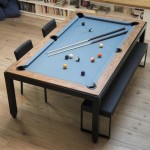Selecting the Ideal 6-8 Person Dining Room Table
The dining room table serves as a focal point for meals, gatherings, and everyday activities within a home. Choosing the right table involves careful consideration of size, style, material, and functionality. A 6-8 person dining room table is particularly versatile, accommodating both smaller, intimate meals and larger gatherings with family and friends. This article explores key factors to consider when selecting such a table.
Determining the Appropriate Size and Shape
The dimensions of the dining room are a crucial factor in determining the appropriate size and shape of a 6-8 person dining room table. Before commencing the selection process, measure the available space meticulously. Ensure sufficient clearance around the table for comfortable seating and movement. A minimum of 36 inches, and preferably 42-48 inches, should be allowed between the edge of the table and any walls or furniture. This space allocation prevents feeling cramped and allows individuals to easily pull out chairs and navigate the room.
The number of individuals regularly using the table should also influence size selection. While a 6-8 person table can comfortably accommodate larger groups, the typical daily usage might involve fewer individuals. If space is limited, consider an extendable table. These tables incorporate leaves or folding mechanisms that allow for expansion when needed, while maintaining a smaller footprint during regular use. This flexibility is particularly beneficial for apartments or homes with smaller dining areas.
Shape is another significant consideration. Rectangular tables are the most common choice, providing ample surface area and a traditional aesthetic. They work well in longer, narrower dining rooms. Oval tables offer a similar seating capacity to rectangular tables but with softer lines, potentially making the room feel less formal. Round tables foster conversation and create a more intimate dining experience, but they may not be as efficient in utilizing space, especially in rectangular rooms. Square tables are best suited for square dining rooms and offer a balanced aesthetic. The ideal shape ultimately depends on the room's dimensions and the desired aesthetic.
Exploring Material Options and Durability
The material composition of a dining room table significantly impacts its appearance, durability, and maintenance requirements. Numerous material options are available, each possessing distinct characteristics. Wood remains a classic and popular choice, offering warmth and versatility. Different types of wood, such as oak, maple, walnut, and pine, vary in hardness, grain pattern, and color. Hardwoods like oak and maple are more resistant to scratches and dents, making them suitable for high-traffic areas. Softwoods like pine are more affordable but require greater care to prevent damage.
Glass tables offer a modern, minimalist aesthetic. They can make a room feel more spacious due to their transparency. However, glass tables require frequent cleaning to remove fingerprints and smudges. Tempered glass is essential for safety, as it is stronger and less likely to shatter than regular glass. Metal tables, often constructed from steel or aluminum, provide a contemporary and durable option. Metal is resistant to heat and moisture, making it suitable for families with young children. However, metal tables can sometimes feel cold or industrial, requiring careful styling to create a welcoming atmosphere.
Other materials, such as stone (granite, marble, or quartz), are increasingly popular for dining room tables. Stone tables offer a luxurious and durable surface that is resistant to heat and scratches. However, stone tables are typically heavy and expensive. Laminate and veneer tables provide a more affordable alternative to solid wood, offering a similar appearance at a lower cost. However, these materials are less durable and may be susceptible to damage from moisture or heat.
When considering materials, prioritize durability and ease of maintenance. A dining room table is a significant investment, and selecting a material that can withstand daily use and resist wear and tear will ensure its longevity. Consider the lifestyle of the occupants and the frequency of use when making this decision.
Considering Style and Design Compatibility
The style of the dining room table should complement the overall aesthetic of the dining room and the home in general. Numerous design styles are available, ranging from traditional to modern, rustic to contemporary. Selecting a table that harmonizes with the existing furniture and décor will create a cohesive and visually appealing space.
Traditional dining room tables often feature ornate details, such as carved legs, intricate moldings, and rich wood finishes. These tables typically evoke a sense of formality and elegance. Modern dining room tables emphasize clean lines, minimalist designs, and neutral colors. They often incorporate materials such as glass, metal, and light-colored wood. Rustic dining room tables celebrate natural materials and textures, often incorporating reclaimed wood, exposed grain patterns, and distressed finishes. These tables create a warm and inviting atmosphere.
Contemporary dining room tables blend elements of modern and traditional styles, creating a unique and eclectic aesthetic. They may feature bold colors, unconventional shapes, and mixed materials. The leg design of the table significantly impacts its overall style. Tapered legs offer a classic and refined look, while splayed legs provide a mid-century modern feel. Pedestal tables feature a single central support, creating a clean and uncluttered appearance. The edge profile of the table also contributes to its style. A bullnose edge is soft and rounded, while a square edge offers a more modern and angular look.
Consider the color palette of the dining room when selecting a table. A table that complements the existing colors will create a harmonious and balanced space. If the dining room features a neutral color scheme, consider adding a pop of color with a brightly colored table or chairs. The design of the chairs should also complement the style of the table. Matching chairs can create a formal and coordinated look, while mismatched chairs can add a touch of personality and individuality. The overall goal is to select a dining room table that reflects personal style and creates a welcoming and functional space for meals and gatherings.
Evaluating Functionality and Features
Beyond aesthetics, the functionality of a 6-8 person dining room table should be carefully evaluated. Factors such as storage, extendability, and ease of cleaning contribute to the overall user experience. Some dining room tables incorporate built-in storage, such as drawers or shelves, which can be used to store placemats, napkins, or other dining essentials. This feature is particularly beneficial for smaller dining rooms where storage space is limited.
As previously mentioned, extendable tables offer flexibility in seating capacity. These tables are ideal for individuals who frequently host larger gatherings but do not have the space for a large table on a permanent basis. The extension mechanism should be smooth and easy to operate. Consider the type of extension mechanism, such as butterfly leaves, drop-leaf extensions, or self-storing leaves. The choice depends on personal preference and the frequency of use.
The surface finish of the table should be resistant to scratches, stains, and heat. A durable finish will protect the table from everyday wear and tear and make it easier to clean. Consider a finish that is water-resistant, especially if young children are present. The weight capacity of the table is also an important consideration, particularly for tables constructed from glass or metal. Ensure that the table can safely support the weight of the tableware, food, and individuals using it. Check customer reviews and product specifications to verify the table's weight capacity.
The ease of cleaning is a crucial factor, particularly for families with young children or individuals who frequently entertain. A table with a smooth, non-porous surface will be easier to wipe clean. Avoid tables with intricate carvings or details that can trap dirt and debris. Regular cleaning and maintenance will prolong the life of the dining room table and keep it looking its best.
Accessibility is another important aspect of functionality. Consider the height of the table and chairs to ensure comfortable seating for individuals of various heights. The distance between the table and the floor should be adequate to allow for comfortable legroom. Selecting chairs with armrests can enhance comfort, particularly for longer meals. The overall functionality of the dining room table should align with the individual's needs and lifestyle.

Camden Rustic Oak 6 8 Seater Dining Table

6 Seater Garden Dining Set Glass Table With Grey Chairs Grosseto Beliani De

Murray Solid Wood Metal Oval Dining Table 6 8 Seater

Brewster 6 8 Seat Black Dining Table And Six Madison Chairs

Tivoli Weathered Oak 6 8 Seater Table Fontana Blue Velvet Chairs

Vanalen 6 To 8 Extendable Persica Seater Dining Table Set Urban Ladder

Dining Table For 6 8 Person Kitchen With Metal Frame

Tate Dining Table 6 8 Seater Lifely

Tate Dining Table 6 8 Seater Lifely

Bern 6 8 Seater Oak Extending Dining Table With Metal Legs Daals Com

